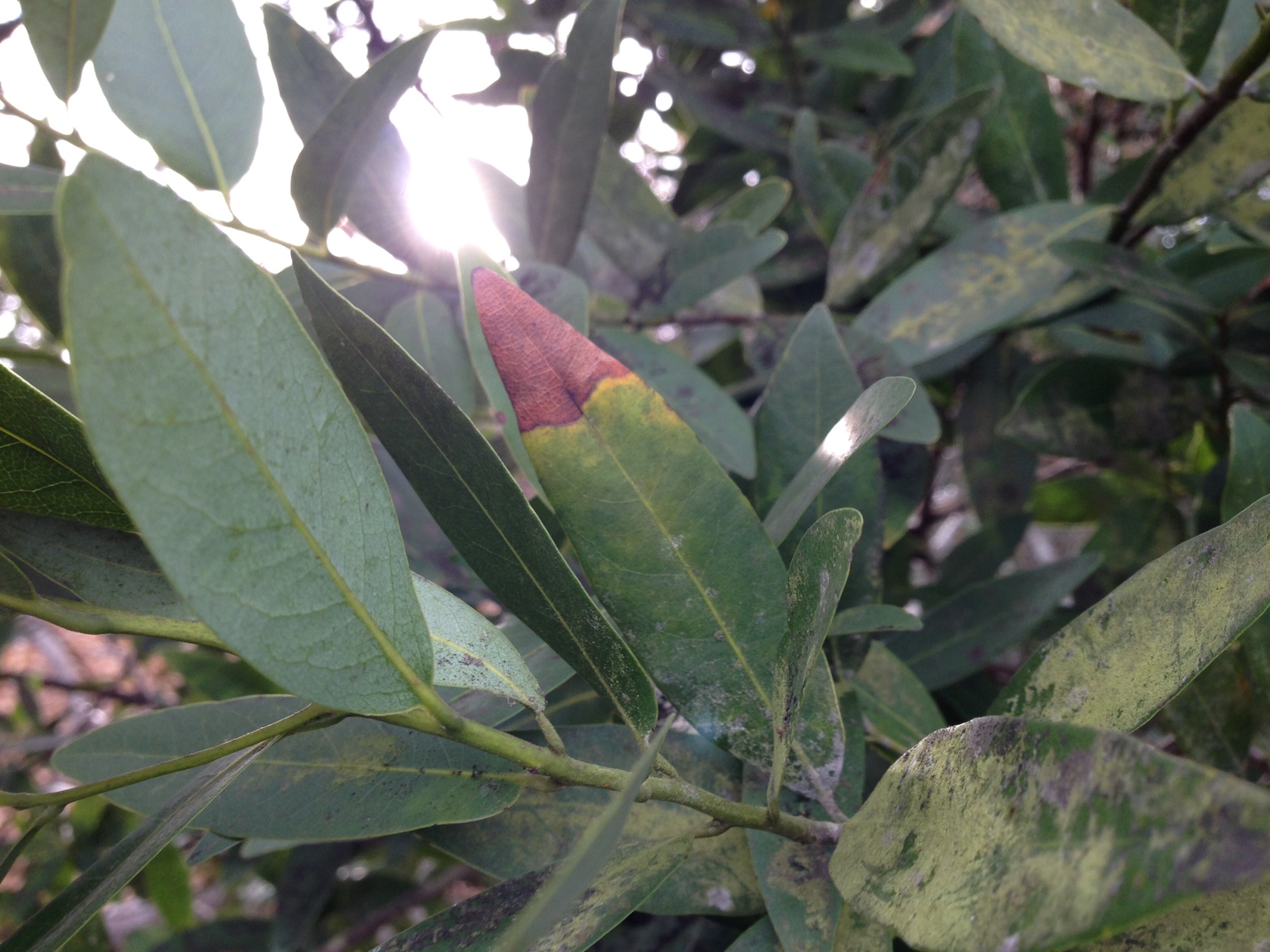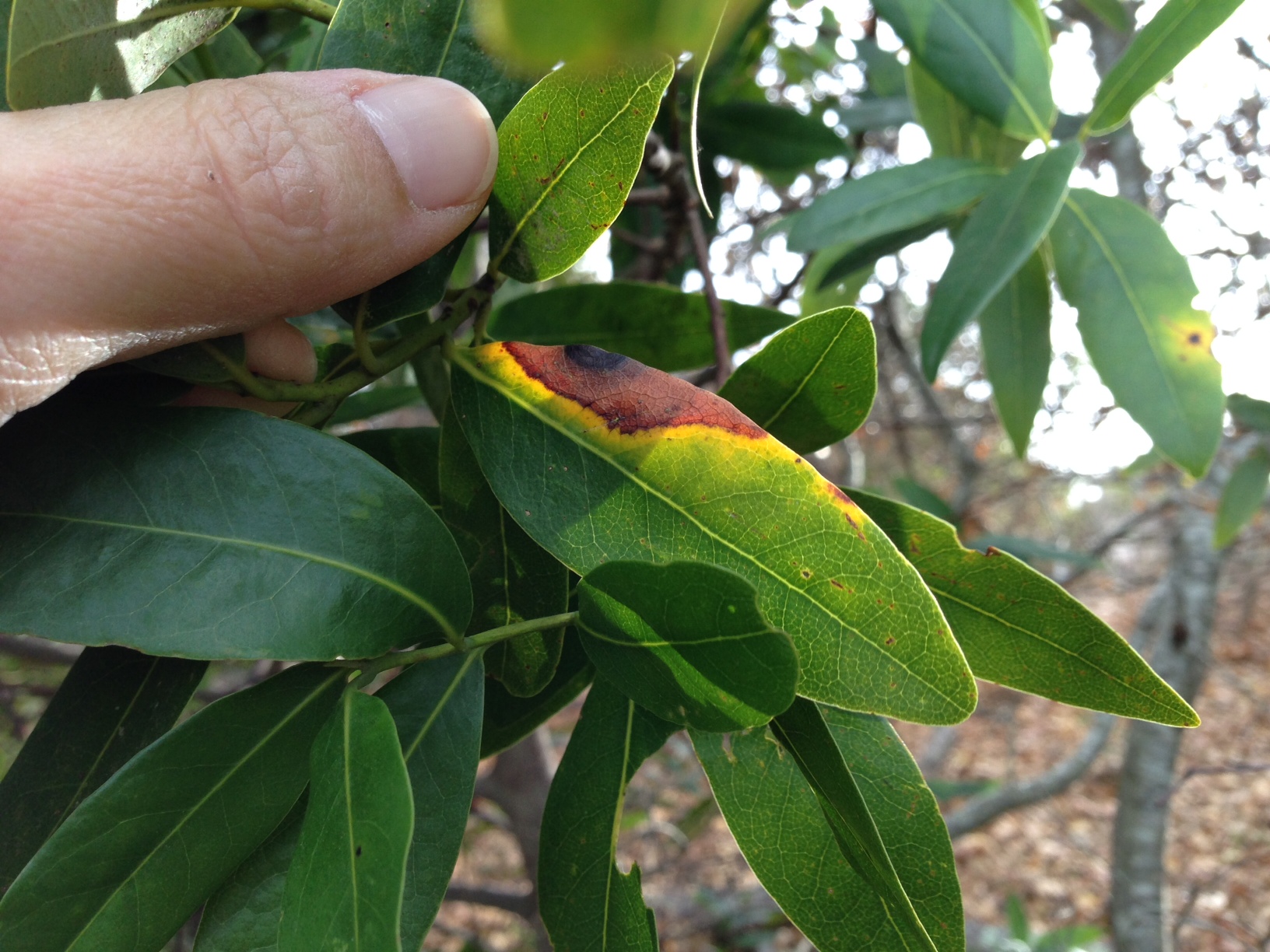General Northern California
Thanks in advance.
12/2/13: I returned to the tree in question and agree that a lot of the black moldiness might be sooty mold (after looking at photos of this stuff, it looks the same). But I also found leaves on the same plant more in line with what a P. ramorum infected leaf looks like, which I ha posted. As I mentioned in my comment below, this tree is in Sonoma county on the western edge of Petaluma in mixed evergreen woodland.
Posted
by: Vanessa Dodge
(3 points)
![]()
Posted: December 1, 2013
Posted
by: Dan Stark
(3 points)
![]()
Posted: December 3, 2013
http://www.ncbi.nlm.nih.gov/pubmed/19...
The pathology of Phytophthera ramorum on Laurel is blackened tip of a a few leaves in a bush. There is a picture here
http://nature.berkeley.edu/garbelotto...
To me it looks like the Laurel you took an image has a sooty mold caused by a fungus feeding on sugar deposited on the leaf by aphids dew flicked down from the trees above.
Posted
by: David Hughes
(67 points)
![]()
Posted: December 2, 2013
Thanks for your quick response. I'll admit it was a pleasant surprise to see the answer to my query came from Zombie-Ant Guy himself (just read an excellent article about you and your colleague, Harry Evans in Aeon two days ago, which is how I found this website). I have a follow-up to this question (and your answer) but since it includes photos I will just do a new post. Thanks again. over 10 years ago.
http://www.suddenoakdeath.org/diagnos...
If it convinces you that the symptoms you saw were sudden oak death then you may wish to have a diagnostic test run in a lab. To do this, you collect a sample of leaves from the plant and take it to your Agricultural Commissioner or local co-operative extension office (this requires a sample of 10 or more leaves which must be kept refrigerated and handed in for testing within 24 hours).
Posted
by: Lindsay McMenemy
(4 points)
Posted: December 2, 2013
Thanks for your response. I was hiking (and live) in Sonoma county. The laurel in question is quite near my home, so I will go back and take some more (and hopefully better) photos of individual leaves today. The bay laurel right next to the scurvy-looking one I posted photos of has black spots on it very like the ones you posted. Btw - is this the proper forum for this line of inquiry - I just noticed that the site is supposed to be about food plants. over 10 years ago.
Yes, I thought that about the spots too, the only thing missing is the tip lesions! With some more photos we could perhaps contact somebody who works with Sudden Oak death and get their opinion. You are correct about PlantVillage being only for edible plants but bay laurel nuts (and acorns) are edible so your post is valid and also very interesting. Good to raise awareness of this important pathogen over 10 years ago.
Rosalind Peterson writes, "What is the common denominator for deteriorating tree health in so many areas of the United States? Air pollution, white haze, climate change, increasing UV radiation, higher humidity caused by persistent jet contrails, jet fuel emissions, lack of sunlight from man-made clouds, or climate change produced by persistent jet contrails? There are over 50+ weather modification programs ongoing, according to NOAA records, in the United States. What impact does this chemical manipulation of our weather have on the regional micro-climates that are needed for tree, plant and agricultural crop health?"
"All of our local, state and federal representatives need to be taking a closer look at this looming problem ... not just recommending the cutting down of trees."
Source: http://newswithviews.com/Peterson/ros...
More information about the harmful effects of aluminum and geoengineering on trees and plants
http://www.agriculturedefensecoalitio...
Documentary about airborne chemical aerosol spraying: "What in the World Are They Spraying?"
http://www.youtube.com/watch?v=-K9rXy...
Posted
by: Alan Smith
(2 points)
![]()
Posted: January 1, 2014








Thanks for the new images. The new 3 images show the dark lesions with yellow halos - another diagnostic characteristic of Sudden Oak Death on California laurel. From what I have read, these lesions tend to occur where water collects on the leaf - usually at the tip - but not always. I think your instincts were correct but let's see if we can get a real expert to share his/her opinion. More soon.... over 10 years ago.